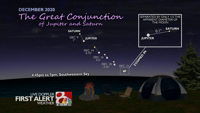Nearly 800 years ago in 1226 two planets visibly "aligned" in the night's sky. It was the conjunction of Jupiter and Saturn. In a rare event, they appeared extremely close together, 1/15 of the Moon's apparent width.
This happened on March 4th, 1226 - just a few months before the death of Francis of Assisi to give you an idea of the time frame. It was also the 20th year of Genghis Khan's reign and a year before his death in 1227.
While 1226 was the last time an extremely close conjunction between Saturn and Jupiter was visible, it isn't the last time it has happened. In fact, conjunctions between Jupiter and Saturn happen every 19.6 years. Because of the angle at which Jupiter (1.3º) and Saturn (2.5º) both orbit the sun, when they meet up every 19.6 years they will be at varying distances from each other, anywhere from 4º or less. Therefore, it is even more rare that we get to see a conjunction that is less than 1º.
In 2020 we get to see one of the rare close encounters, a conjunction of a tenth of a degree. To find a close conjunction similar to the one in 2020, besides 1227, you have to go back to the 17th century.
In the summer of 1623 Galileo was enjoying the telescope he made 14 years prior, in 1609. Little did he know there was a conjunction of planets happening. Even if he had known, he wouldn't have seen it. This planetary alignment happened within 13º of the sun and was therefore not visible from Earth. Sad day for Galileo.
Now, in 2020, we get to see this spectacle in the coming weeks. If you look each night you'll notice the two planets getting closer together each evening.
The "Great Conjunction" as it is being called, will finally occur on the night of the winter solstice.
That's right! Coincidentally, at the start of the longest night of the year we will see two planets appear separated by a tenth of a degree (0.1º). That's about one-fifth the apparent diameter of the Moon!

When looking through a telescope or even binoculars you'll likely be able to see both Saturn and Jupiter in the same frame (already a rarity) as well as their Moons!
Of course, while these two gas giants will "appear" close together, they will still be hundreds of millions of miles apart. Jupiter is nearly 545 million miles from Earth, and Saturn another 455 million miles beyond that.
Jupiter is the largest planet in our solar system and will shine brightest. Saturn will have a golden hue to it.
When these two planets "meet" on December 21st, be sure to watch during twilight and just after the sun sets. These two planets will also "set" pretty quickly and you don't want to miss it! Look to the west.
Some have dubbed this meeting the "Christmas Star" because the two planets together on December 21 will appear so large and bright. However, I'll note that both astronomers and biblical scholars have determined the star of Bethlehem during Jesus' birth could not have been a conjunction between Jupiter and Saturn as a conjunction during that time would have been only about a half of a degree, or about the width of the Moon, and therefore not so bright. Certainly not as bright as we'll be seeing this December 21. Also remember that this event can occur at any time of year, not just during December. It all depends on the 19.6 year cycle.
While this event will also occur in 2040 and 2060, it won't be until March 15, 2080 that they'll be visibly this close again, or maybe even just a tad closer than we get to see in 2020.
If you see the Christmas Star on December 21 be sure to send us your photos through the KOMU 8 Weather App!
"time" - Google News
December 22, 2020 at 09:26AM
https://ift.tt/3mJN8fD
The Great Conjunction: Planets visibly "double-up" for first time in nearly 800 years - KOMU 8
"time" - Google News
https://ift.tt/3f5iuuC
Shoes Man Tutorial
Pos News Update
Meme Update
Korean Entertainment News
Japan News Update
Bagikan Berita Ini














0 Response to "The Great Conjunction: Planets visibly "double-up" for first time in nearly 800 years - KOMU 8"
Post a Comment